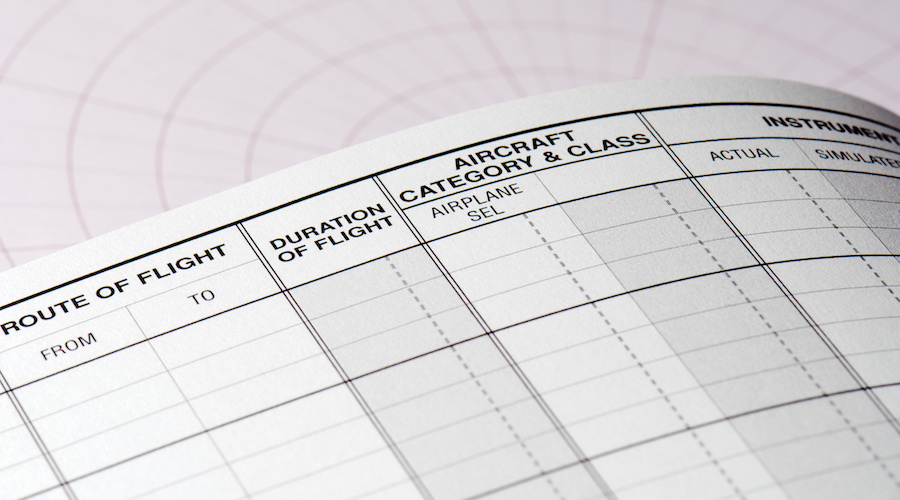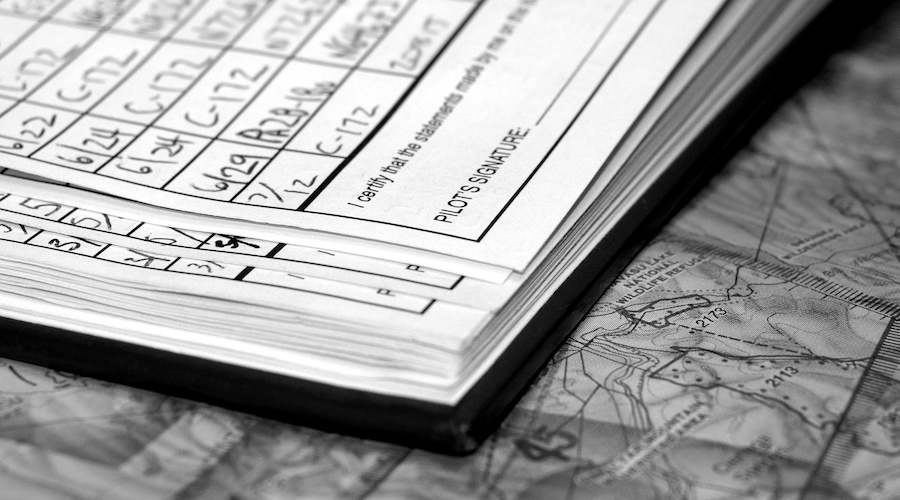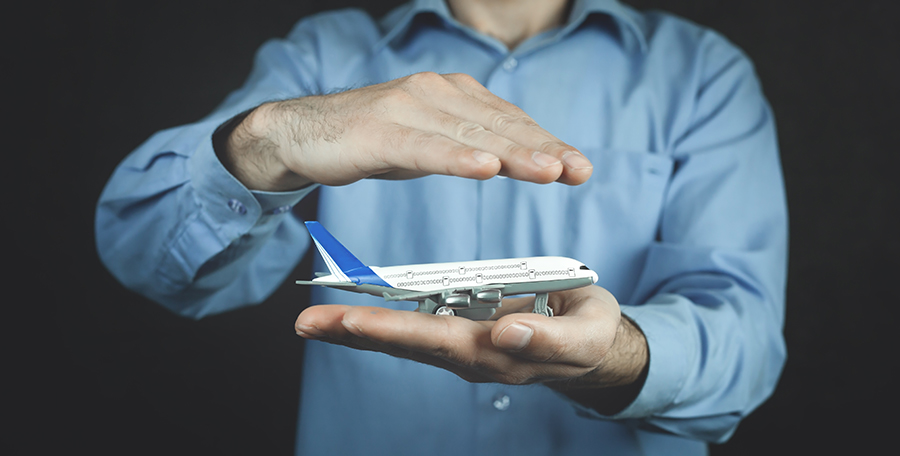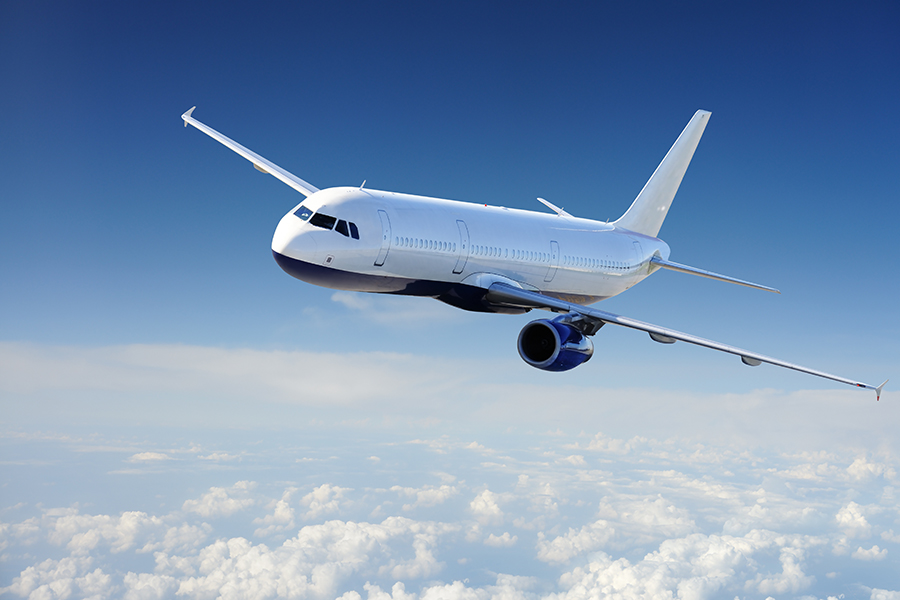-
What counts as Flight Time?
-
How do you record flight time?
-
What to log?
-
Types of logging
-
When can you log Pilot in Command time?
- Being the Sole Occupant
- Being the Sole Manipulator of the Controls
- Acting as PIC of a dual pilot aircraft
- Acting as a Safety Pilot
- Giving instruction as a flight instructor
- Receiving instruction as a student
- Receiving instruction after getting your PPL
-
Solo Time
-
Logging Second in Command Time
-
Logging Cross Country Time
- What counts as a cross country flight?
- Which cross country flights can count for licenses?
-
Logging Night Flight Time
-
Logging Instrument Time
-
Logging Simulator Time
-
Misrepresenting Flight Time
-
Conclusion
Question: When is a flight, not a flight?
Answer: When you don’t log it.
The importance of accurately logging flight time cannot be overstated for pilots. A meticulously maintained logbook is required for future certification, ratings, and proof of currency.
Logged proof of flight time is required by the FAA, and can also be asked by employers or insurance companies at their discretion, so a pilot needs to be extremely diligent about logging all flight time correctly.
Failure to log time properly can even result in action from the FAA including not just substantial fines, but even suspension or revocation of previously obtained certificates. It’s way better to know the flight time logging regulations inside and out in order to avoid any nasty surprises on your next ride with an FAA inspector.
What counts as Flight Time?
So when does flight time actually start? Are you just supposed to use the Hobbs time? According to the FAA, CFR § 1.1 has a specific definition for flight time for pilots. Pilot time, or the flight time relevant for a pilot, commences when the aircraft first moves under its own power when the intention is to attain flight. It ends when the aircraft comes to a rest after landing.
At first glance, this seems pretty clear-cut. Real life, though, has a way of complicating matters. This definition does not provide for any deviation from the standard power-up to taxiway to runway to departure routine.
What if the aircraft requires a de-ice prior to departure? Would the time spent on the de-ice pad count as flight time? Even if the aircraft is not moving or the engines are not running?
The FAA has had to publish letters of interpretation to clarify scenarios such as the one described above. According to one such interpretation published by the FAA in 2004, de-icing is one of the procedures that are “preparatory to flight”.
So, the time taken for the aircraft to move under its own power from the gate to the de-ice pad, the time spent during de-icing with the aircraft engines powered off, and the time taken for the taxi to the runway are all included in flight time.
The FAA concludes that since there is a continuing ‘purpose of flight’, the flight time keeps accruing even in the case of an unforeseen mechanical problem that causes the aircraft to remain at the gate, provided that the pilot is needed onboard.
How do you record flight time?

Some flight schools or small operators may use Hobbs time or Tach time as a reference and may then make some adjustments to account for the difference.
Hobbs time refers to the time shown on the Hobbs meter and generally records the duration the engine is running, using oil pressure.
In some aircraft, the Hobbs meter is activated by the master switch being turned on, in others, it’s activated by a pressure switch connected to the landing gear. This means it’ll only measure the time where the aircraft is literally ‘in flight’.
There’s also ‘Tach time’. Tachometer time is usually recorded for maintenance purposes, such as deciding when to change the engine oil. The tach time is linked to the engine RPM, and it gives a less accurate reading at low RPM such as when taxiing or stopped with the engine running.
There can be up to a twenty percent difference in Hobbs time and Tach time, so the pilot needs to double-check the way the flight time is being calculated, while also keeping in mind how their specific aircraft activates its Hobbs meter. The most accurate method is to manually record the “chocks off” and the “chocks on” time for each flight.
What to log?
The FAA does not specify a particular format for a logbook, and it just requires that the logs should be presented in “a form and manner acceptable to the Administrator.” The regulations in CFR § 61.51 describe the minimum types of data that should be recorded by the pilot in the logbook. Each logbook entry should record the basic information for the flight including:
- Date of the flight.
- Total flight or lesson time.
- Departure and arrival locations.
- Type and registration of the aircraft.
- Name of the safety pilot, if any.
The logbook should also have a record of the pilot’s prior experience and training, including the type of flight hours previously flown:
- The amount of Solo flying time.
- The number of hours where the pilot was the Pilot in Command (PIC).
- The number of hours where the pilot acted as Second in Command (SIC).
- The flight and ground training received from authorized instructors.
The conditions of the flight should also be noted down.
- The number of daytime or nighttime hours flown.
- The number of actual instrument hours flown.
- The number of simulated instrument hours, either in flight or using a training device.
Incomplete flight hours are added as tenths of a whole hour. For example, a flight time of 1 hour and 20 minutes would be logged as 1.3 hours.
Types of logging
All flight time is not the same. Flight time can be logged under different categories depending on the role of the pilot, the time of day, the distance traveled by the aircraft, and the conditions of the flight.
Flight time categories have specific requirements that need to be met in order for the time to be legal. Even genuine mistakes can be construed by the FAA to be made with the intent to artificially pad the time to get a rating, so pilots need to be very clear about the regulations regarding each category.
Flight time can be logged under Pilot in Command, Solo, Second in Command, Cross Country, Night, Simulated Instrument, and Actual Instrument categories. The total flight time is the sum of the pilot’s flight time in all the categories and is called Total Time (TT).
When can you log Pilot in Command time?
Ah, PIC time. Pilot in Command time is one of the most difficult types of time to determine. Confusingly, there is a difference between acting as a PIC and being able to log PIC time. What does it mean to act as a Pilot in Command?
According to 14 CFR § 1.1, The PIC is the person who has the final authority and responsibility for the operation and safety of the flight. In order to be qualified as a PIC, the person needs to have a current flight review as well as the relevant class, category, and type rating for the aircraft they are operating. Finally, if the flight has two pilots, they need to decide amongst themselves and designate who should bear the responsibility for the flight.
Other regulations may also come into play, such as an instrument rating requirement for a flight operating under IFR. Regardless of how many pilots are on board, there can only be one pilot responsible for the flight, so only one pilot can act as the Pilot in Command according to the Part 1.1 definition.
Logging PIC time is a different matter altogether and is defined using another section of the regulations, 14 CFR § 61.51. It’s possible to act as a PIC but not log PIC time, log PIC but not act as PIC, and even act as PIC but not log any time at all!
Being the Sole Occupant
Let’s start with the simplest scenario: The pilot can log PIC if they are the sole occupant of the aircraft. For pilots that are pre-PPL, this is usually logged under solo flight time since PPL requirements include solo time. After meeting the requirements for licenses or ratings, there’s not really much use for more logged solo time, so this time is usually logged as PIC time.
Being the Sole Manipulator of the Controls
Okay, what if the pilot is not the sole occupant? This clause of the rules allows the pilot to log PIC for the aircraft they are rated for if they are the sole manipulator of the controls. If there are two pilots present on an aircraft that only requires one pilot and they’re taking turns flying, each of them is only able to log PIC time for the duration they were operating the controls.
What happens if there are two pilots sitting up front in a Cessna Skyhawk that requires only one pilot? Only one of them can log pilot time. The other pilot can’t log anything, and as far as their logbook is concerned, they’re just a passenger. Ouch. Exceptions to this rule include an instructor giving flight instruction to a student and some cases involving a safety pilot.
Acting as PIC of a dual pilot aircraft
The third and final provision in the rules for logging PIC time allows pilots that act as PIC of an aircraft that requires more than one pilot under the type certification or the regulations in which a flight is conducted. Remember, acting as PIC is defined by the 14 CFR § 1.1 requirements described previously.
Aircraft that are certified for dual pilot operations will have both of the pilots able to log total time, but only one of them can log Pilot in Command time. The other pilot has to log Second in Command time.
Acting as a Safety Pilot
This part of the regulation deals with scenarios including one where one pilot is undergoing simulated instrument flying. Simulated instrument flight involves the pilot wearing a vision limiting device such as a hood to restrict their view outside the cockpit. In this case, the other pilot acts as a safety pilot; watching out for traffic, birds, or other obstacles.
Simulated instrument flight cannot be carried out without a safety pilot, and cannot be carried out in actual instrument conditions. Even for an aircraft rated for single pilot operation, in these conditions there are now two pilots required for the safe operation of the flight. As described above, the pilot under the hood can log PIC time under the Part 61 definition as they are the sole manipulator of the controls.
But if the pilots decide amongst themselves to make the safety pilot act as the Pilot in Command under the Part 1 definition described above as the person responsible for the flight, both of them can log PIC time for the duration one pilot is under the hood. If the pilots decide not to make the safety pilot the PIC under Part 1, the safety pilot logs Second in Command time for the time the other pilot is under the hood.
Giving instruction as a flight instructor
According to FAR 61.51, flight instructors get to log the entire flight under PIC time while they are giving instruction. FAR 61.195 adds that they can only give instruction as long as they are certified to act as an instructor with the applicable category, class, and type rating for that aircraft and flight condition.
This means they need to be a multi engine flight instructor to instruct in a multi engine aircraft, instrument rated to give instrument flight instruction, and so on.
Instructors log this PIC time under the heading of Dual Given. They also need to sign their student’s logbook and include the date and duration of instruction.
Receiving instruction as a student
A student pilot can only log pilot in command time when on a solo flight, having a valid endorsement for solo flying by the instructor.
Receiving instruction after getting your PPL
Students who are rated in the category and class of the aircraft can now log time as Pilot in Command. For small airplanes that don’t have a type rating, this means once students have passed their private pilot checkride, they can log their continuing instruction as PIC. This also applies to training towards endorsements such as high performance or tailwheel.
These entries are logged as Dual Received and need to include a description of the exercises performed, the lesson duration, and the signature and endorsement by the flight instructor.
Solo Time
The pilot can only log solo flight time if they are the only person on board the aircraft. Even if there aren’t any other pilots aboard, and you’re only carrying passengers who have no idea how to operate an aircraft, you still can’t log your flight as a solo. Solo time is usually logged by pilots under training as part of the requirements for a license such as a Private Pilot’s License (PPL).
Most pilots usually don’t log solo time after getting their PPL, unless they’re planning to pursue a Commercial Pilot’s License (CPL). After meeting the requirements, most pilots just log it under PIC time.
Logging Second in Command Time
Second in Command flight time requires the pilot to be performing flight duties on an aircraft that requires more than one pilot for legal operation. During the time they are not operating the aircraft controls, they are acting as SIC instead of PIC as described previously.
Unfortunately, a large number of pilots mistakenly log right seat time in aircraft rated for single pilot operation, leading to a disappointing situation when they present their logbook while going for their next checkride.
In 2018, the FAA issued an amendment to its regulations and issued an advisory circular allowing for the creation of the Second-in-Command Professional Development Program.
The new program enables Part 135 operators to allow pilots to log second in command time in aircraft that are rated for single pilot operation. This, however, only applies to operators participating in the program, so pilots need to make sure they are eligible before logging SIC flight time under this relatively new rule.
Logging Cross Country Time
The rules about cross country flight time have a few caveats as well, so care is needed in order to make sure it’s being logged correctly. Cross country flying has different distance requirements in order to count as valid aeronautical experience depending on the license the pilot is aiming for.
What counts as a cross country flight?
The general definition of cross country flying is that it must involve a landing at a point other than the point of departure, and the pilot needs to employ navigation techniques such as Pilotage, Dead Reckoning, or Radio Navigation.
So would every flight to a different airport count as cross country? What about airports that are right next to each other? You would think there’s not a whole lot of country being crossed there.
The general definition of cross country time doesn’t have any distance requirement, so yes, even very short flights such as repositioning flights between airports within a city can be logged as cross country flight time.
Which cross country flights can count for licenses?
Cross country time requirements for licenses or ratings are stricter and need a minimum straight line distance between the airports in order to qualify, depending on the license or rating.
The minimum required distance needs to be more than 50 nautical miles for it to count towards a PPL, CPL, or an Instrument rating. Each leg of the flight does not have to meet this distance requirement. The cross country time is valid even if one stop on the trip meets the requirement. Cross country time counting towards a Sport Pilot Certificate reduces the required distance to only 25 nautical miles.
Confusingly, Cross Country time is logged differently for an ATPL. While an ATPL needs a 50 nautical mile straight line distance from the departure airport to count as cross country time, the regulation makes no mention of a landing requirement. Military pilots are also eligible to log their cross country flight times this way.
Keep in mind that a PPL does require at least one flight that’s 150 nautical miles long, with at least one leg having a straight line distance of 50 nautical miles between airports. Similarly, one of the CPL requirements is a two hour long flight with one landing point at least 100 nautical miles from the origin. Making any stops in between these legs would invalidate the flight, and overlooking this particular rule has ruined a lot of checkrides before they’ve even started.
Part 135 pilots need 100 hours of VFR cross country time of 500 IFR cross country time in order to act as PIC. This flight time is counted using the basic definition of cross country time and has no minimum distance requirement.
Given the myriad of rules and exemptions related to cross country time, it’s recommended to log cross country flights meeting distance requirements separately, in order to make it easier to check if the requirements for PPL, CPL, and IR are met.
You should keep the basic definition of cross country flight time in mind too since it’s less restrictive than the time needed for licenses. Keep track of flights that meet the basic definition so that you don’t sell yourself short when totaling your hours for your resume.
Logging Night Flight Time
When does the night begin and end? Sunset to sunrise? Logging night flying time is a bit more complicated than that.
Different rules come into effect as the sun goes down. There are three important times where rules change in the evening: sunset, half an hour after sunset, and one hour after sunset. Similarly, sunrise, half an hour before sunrise, and one hour before sunrise are important times in the morning.
You can’t start logging night flight time as soon as the sun goes down. During the period from sunset to sunrise, the only requirement is that aircraft must have their position lights on.
Night flight time can only be logged from the end of evening civil twilight to the start of morning civil twilight.
You can check the Air Almanac to get accurate times for civil twilight for any location in the world throughout the year. But as a rough guideline, evening civil twilight ends half an hour after sunset, and morning civil twilight starts half an hour before sunrise. That’s when it’s legal to log those precious night flight hours.
Crucially, night landings are only counted as such if they’re performed one hour after sunset till one hour before sunrise. Yes, there’s a thirty minute interval where you can log night flying time but not a night landing for currency.
If you’re carrying passengers one hour after sunset till one hour before sunrise, night currency requirements come into play, depending on the type of flight operator.
Part 91 pilots need to do three nighttime takeoffs and landings to a full stop in the past 90 days in order to be current.
Pilots flying for Part 135 operators can act as SIC, but they can’t act as PIC if they’re not current. They also need three nighttime takeoffs and landings, but these are allowed to be touch and goes.
Logging Instrument Time
Instrument time refers to the flight time where the aircraft is flown entirely using the aircraft instruments and without reference to outside visual references.
If the aircraft is being flown in low visibility where Instrument Meteorological Conditions (IMC) exist, the flight time can be logged as Actual Instrument time. If Visual Meteorological Conditions are in effect, the pilot can wear a vision limiting device and log Simulated Instrument time. A safety pilot is required in Simulated Instrument flights.
Only the portion of the flight where the pilot is solely flying using instruments can be logged under instrument time, not the entire flight.
Logging Simulator Time
There are three types of simulators according to the FAA. These are Aviation Training Devices (ATDs), Flight Training Devices (FTDs), and Full Flight Simulators (FFS). The simulator at your local flight school is probably an ATD. There are two types of ATDs, Basic and Advanced.
Part 141 schools that have FTDs need to have them approved by the FAA. For logging simulator time, it is best to have the simulator serial number noted down with your entry. Attaching a copy of the Letter of Authorization issued by the FAA for the simulator is also recommended.
Simulator time is not counted in your Total Time. Despite the fact that the FAA does not have a formal definition of what can and can’t be counted as Total Time, the general practice is to not include simulator time in your total flying hours and to just log it separately.
The FARs do have provisions that allow a limited number of simulator hours to count towards your ratings, but this time is not counted as flight hours by employers reviewing your logbook.
Misrepresenting Flight Time
14 CFR § 61.59 deals with the falsification, reproduction, or alteration of documents including logbooks. It prohibits making false entries or causing them to be made in order to show compliance with requirements for ratings or certificates.
While 61.59 mentions suspension and revocation as the possible penalties, the actual consequences can be far more severe. The pilot logbook is a legal document that you submit to the FAA, and misrepresentations can mean committing federal perjury that can lead to jail time.
Remember that the FAA, any potential employers, and insurance companies reviewing your logbook have gone through countless other pilot logbooks before yours. They are likely to have seen pretty much every way dodgy pilots have tried to pad their hours or exploit loopholes in regulations.
Not matching up to the level of experience expected after looking at your logbook will invite closer scrutiny into your entries. Misrepresenting flight hours and experience is likely to backfire, so it is best to be honest about logging your flight hours.
Now you might not even think about wilfully misrepresenting your flight hours, but the problem is that the FAA does not know that. It’s possible to have an incorrect interpretation of the FARs and keep on logging flight time that ends up not being legal. That’s why it’s best to be clear on the details and implications of the FARs to make sure your logbook doesn’t end up getting you in trouble.
Conclusion
When you’re making an entry in your logbook, you’re not just jotting down a number or two, you’re writing a legal document. If you’re not logging hard-earned flight hours that you’re entitled to, you’re selling yourself short. If you’re logging time that you can’t log, you’re putting yourself at risk of having your license or ratings suspended or even revoked.
It’s a bit convoluted, but as a pilot, you need to be absolutely clear on the rules and regulations, especially the PIC and Cross Country logging rules. Even pilots with thousands of hours can wind up having a misunderstanding about a requirement or two.
It’s best to brush up on the FARs and the letters of clarification issued by the FAA from time to time. Taking some time to understand the rules can save a lot of headaches and heartbreak down the road.

 @pilotinstituteairplanes
@pilotinstituteairplanes


